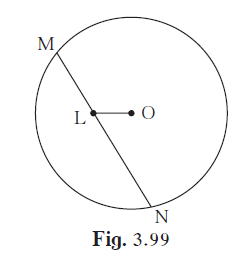In the given figure, seg MN is a chord of a circle with centre O. MN = 25, L is a point on chord MN such that ML = 9 and d(O,L) = 5. Find the radius of the circle.
Chapter 3 – Circle – Text Book Solution
Problem Set 3 | Q 21 | Page 89
In the given figure, seg MN is a chord of a circle with centre O. MN = 25, L is a point on chord MN such that ML = 9 and d(O,L) = 5. Find the radius of the circle.

seg MN is a chord of a circle with centre O.
Draw OP ⊥ MN and join OM.
MP = PN = `(MN)/2 = 25/2`units (Perpendicular drawn from the centre of a circle on its chord bisects the chord)
∴ LP = MP − ML = `25/2-9=7/2`units
In right ∆OPL,
\[{OL}^2 = {LP}^2 + {OP}^2 \]
\[ \Rightarrow OP = \sqrt{{OL}^2 - {LP}^2}\]
\[ \Rightarrow OP = \sqrt{5^2 - \left( \frac{7}{2} \right)^2}\]
\[ \Rightarrow OP = \sqrt{25 - \frac{49}{4}}\]
\[ \Rightarrow OP = \sqrt{\frac{51}{4}} = \frac{1}{2}\sqrt{51} \] units
In right ∆OPM,
\[{OM}^2 = {MP}^2 + {OP}^2 \]
\[ \Rightarrow OM = \sqrt{\left( \frac{25}{2} \right)^2 + \left( \frac{\sqrt{51}}{2} \right)^2}\]
\[ \Rightarrow OM = \sqrt{\frac{625 + 51}{4}}\]
\[ \Rightarrow OM = \sqrt{\frac{676}{4}}\]
\[ \Rightarrow OM = \sqrt{169} = 13 \] units
Thus, the radius of the circle is 13 units.
Explanation:-
Consider a circle with center O and a chord MN. Let OP be perpendicular to MN and OM be another line joining O to M. We need to find the radius of the circle.
By the perpendicular bisector theorem, OP is the perpendicular bisector of MN. Therefore, MP = PN = (MN)/2 = 25/2 units.
We also have ML = 9 units. Thus, LP = MP – ML = 25/2 – 9 = 7/2 units.
Using Pythagoras theorem in right triangle OLP, we get:
${OL}^2 = {LP}^2 + {OP}^2$
Solving for OP, we get:
$OP = \sqrt{{OL}^2 – {LP}^2}$
Substituting the values, we get:
$OP = \sqrt{5^2 – \left( \frac{7}{2} \right)^2} = \sqrt{25 – \frac{49}{4}} = \sqrt{\frac{51}{4}} = \frac{1}{2}\sqrt{51}$ units.
Next, using Pythagoras theorem in right triangle OPM, we get:
${OM}^2 = {MP}^2 + {OP}^2$
Substituting the values, we get:
$OM = \sqrt{\left( \frac{25}{2} \right)^2 + \left( \frac{\sqrt{51}}{2} \right)^2} = \sqrt{\frac{625 + 51}{4}} = \sqrt{\frac{676}{4}} = \sqrt{169} = 13$ units.
Therefore, the radius of the circle is 13 units.
Chapter 3 – Circle – Text Book Solution
Problem Set 3 | Q 21 | Page 89
Click Here to see All the Textbook solution of Circle
